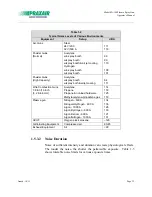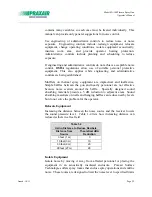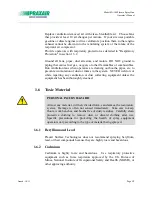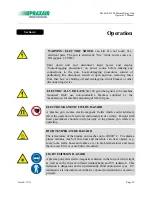
Model SG-100 Plasma Spray Gun
Operator’s
Manual
_____________________________________________________________________________________________________________________
Issued: 10/11
Page
17
breathing zone. In permanent installations, the entire tool is enclosed
except the front; air enters the enclosure at approximately 300 feet/minute
(1.5 m/s). The hood top can be hinged to facilitate loading and unloading
with a crane. In automatic and production spraying, the entire mechanism
is often totally enclosed. Refer to "
Industrial Ventilation
" published by
the American Conference of Governmental Industrial Hygienists
(ACGIH).
Provide exhaust equipment for dry grinding or lapping operations
performed on sprayed coatings. Consult OSHA Occupational Safety and
Health Standard
1910.94, Ventilation
.
Equip spray cabinets used for spraying small and medium size parts with
exhaust ventilation with an air velocity of 200 to 400 feet/minute (1 to 2
m/s) entering the hood opening. This is often referred to as the "face
velocity." Operate the spray equipment within the face area of the hood
and direct the spray into it. Design the cabinet to eliminate turbulent
currents. Refer to "
Industrial Ventilation
" published by ACGIH.
Blasting Rooms
Design and maintain separate rooms for grit-blasting and thermal
spraying. Design of a blasting room should include adequate lighting and
a dry cartridge-type ventilation system having ventilation down draft and
longitudinal air flow at a velocity of at least 80 to 100 feet/minute (0.4 to
0.5 m/s). Thoroughly investigate local, state, and federal regulations
before exhausting directly into the atmosphere. A blasting room should
include a dust collection system that satisfies all laws and local ordinances
for the type of work being done in the room.
Grit-blasting and thermal spraying will require their own independent dust
collectors. Although dry cartridge-type dust collectors are suitable for use
in both the grit blast and thermal spray environments, it is suggested to
refer to
"Industrial Ventilation"
,
a manual of recommended practice
with a compilation of research data and information on design,
maintenance and evaluation of industrial exhaust ventilation systems.
This manual is not intended to be used as law, but rather as a guide. In
addition, the NFPA guidelines should be used for the handling of metallic
and other materials.
Avoid using the grit-blasting room for thermal spraying because the dust
collectors can quickly become clogged with a combination of thermal
spray and grit dust. Also, an accumulation of metallic dust may create a
fire or an explosion hazard.
















































